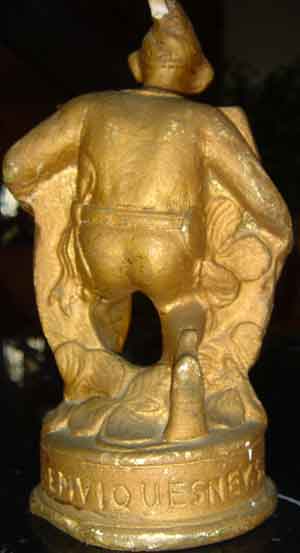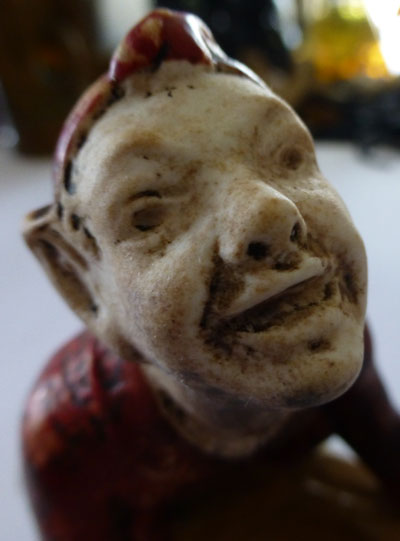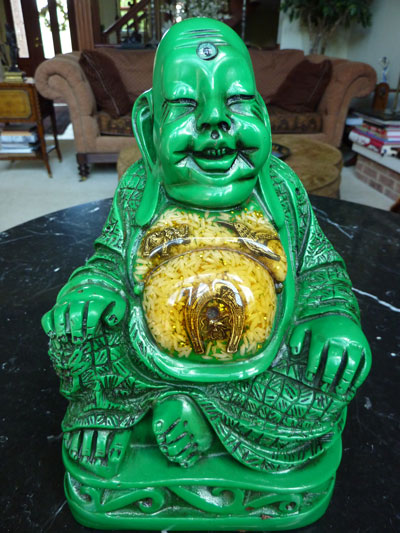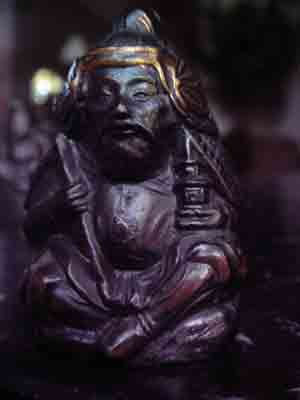Billiken
Of course, first among Lucky Gods at the Church of Good Luck comes Billiken, the God of Things As They Ought To Be. Billiken was Patented in 1908. Please read the Billiken and the Billiken Lore pages for more information.

Joss
Joss is another God, made by the Florentine Alabaster Company in 1908. The word “Joss” is often considered to be a variation on the latin word “Deus”, meaning God. Old-time Chinese temples in the U.S. were sometimes called “Joss Houses” and stick incense is still referred to as “joss sticks”.

Imp-O-Luck
Another image that became a “Good Luck craze” in the 1900s was the Imp-O-Luck. The Imp was created by E.M. Viquesney and issued Design Patent #D62349 in 1923. Mr. Viquesney was already famous for sculpting The American Doughboy, a statue commemorating the U.S. World War I soldier. The Imp was a leprechaun-like figure emerging from a horseshoe surrounded by four-leaf clovers. The Imp-O-Luck was manufactured and sold by Viquesney in a number of formats including a statuette and a pocket piece. The Imp is considered to be one of the minor, yet efficacious Gods here at the Church of Good Luck.
This statuette is plaster or chalkware and stands about 8 inches tall:


This is the pocket piece. It depicts the statuette inside another horseshoe for an interesting visual effect. The back proclaims “Here’s Good Luck” Imp-O-Luck Co. Spencer, Ind:


This the fantastic ceramic Imp-O-Luck ashtray. It is a very detailed slip-casted piece that is painted in 5 colors.



The Imp-O-Luck ashtray was the subject of Design Patent # 65,886 which was issued to Ernest Viquesney on October 28, 1924
For more information on the Imp-O-Luck please visit this website for much interesting information about the Imp, the Doughboy and Mr. Viquesney.
Joy Germ
Another lucky imp-like creature was the Joy Germ. The Joy Germs were mostly made in Germany (of course).
I am not sure why the Joy Germ is holding his mouth wide open. The person who sold him thought perhaps he was used as an ashtray, although he is so small you would have to have excellent aim or else be constantly brushing pieces of live ash all over. Maybe he is holding his mouth open to spread his germs of happiness more easily.

Alibi Ike
Alibi Ike is the God of Excuses. He likes to hear your excuses, so on Ike’s base it says “Tell’M to Him”. Here is a metal statuette of Alibi Ike:

Shichifukujin – 7 Lucky Gods
In Japan there is a tradition of The 7 Lucky Gods or Shichifukujin, who originally came from China and India as well as Japan. Each of the seven also symbolize a cardinal virtue. Additional information on the 7 Lucky Gods is available at this website.
This is a group of small metal Lucky Gods. They are each about 2 inches high and are marked with a number from 1-7 on the bottom. A few are also marked Occupied Japan:

The first of these gods is is Daikokuten, Lucky God of Earth, farmers, the harvest and the kitchen. The second is Ebisu, Lucky God of fishermen, and honest labor. Next we have Benzaiten, Lucky Goddess of art and music and then we show Bishamonten, Lucky God of War. The fifth god is Fukurokuju, Lucky God of Wisdom (he has a big head, LOL.), and the sixth god is Juroujin, Lucky God of Longevity. Finally is Hotei, the Lucky God of Happiness. Hotei is the prototype of the Lucky Buddha. It is often said that rubbing Hotei’s belly brings Good Luck.
Hotei is very popular. In fact, many people have noted that perhaps Hotei was an inspiration in the creation of Billiken. In fact, in Japan the Billiken is sometimes called “The Eighth Lucky God”.
Other Lucky God
The following is another God, inspired by Hotei, but taken to silly extremes. This is a 1967 Russ Berrie & Co. oily jiggler named Eggroll. The tag says “Rub my belly and I will bring you luck”.

This chubby fellow is a Hawaiian take on the Billiken, complete with tufted hair and pointy ears.

A fantastic borrowing of the Lucky Buddha has occured in Mexico, where they make wonderful “Fixed Buddhas”. These large statues contain lukcy charms and rice embedded into them. Here is a standing version, with lucky rice and charms in his belly and Chinese coins embedded in his bag:


Another great Fixed Buddha has embedded lucky Elephants, Hummingbirds and more in his belly and even more things in the base as you can see. The Cross of Caravaca is a great addition. Plus his “Third Eye” is a wonderfully creepy blue doll’s eye:


Here is a bottle Lucky Buddha beer. It’s a light lager made in China. What could be better than a refreshing glass of Lucky Buddha beer after a long day at the Church of Good Luck?

And back to Billiken once again with an image of the small ivory Billiken worn by Rev. Jim:







